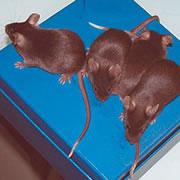 Mice without the DNA for a white-tipped tale can still inherit the feature - thanks to RNA.
Mice without the DNA for a white-tipped tale can still inherit the feature - thanks to RNA.In a discovery that rips up the rulebook of genetics, researchers in France have shown that RNA, rather than its more famous cousin DNA, might be able to ferry information from one generation of mice to the next.
DNA has long been credited with the job of passing traits from parent to child. Sperm and egg deliver that DNA to the embryo, where it ultimately decides much of our looks and personality.
The new study in Nature1 thrusts RNA, DNA's sidekick, into the limelight. It suggests that sperm and eggs of mammals, perhaps including humans, can carry a cargo of RNA molecules into the embryo - and that these can change that generation and subsequent ones.
"It's a very exciting possibility," says Emma Whitelaw who studies patterns of inheritance at Queensland Institute of Medical Research in Brisbane, Australia. "DNA is certainly not all you inherit from your parents."
Tip to tail
Minoo Rassoulzadegan and his colleagues were studying a strain of mice with a mutation in a gene called Kit that produces white fur patches on the tails and feet of grey or brown mice.
The team found something odd when they bred together two mice, each carrying one normal copy of the Kit gene and one mutated copy. Most of the mice that inherited two copies of the normal gene inexplicably still had a white tail tip. They appeared to ignore the DNA instructions written in their normal Kit gene.
The team found hints that RNA might be responsible for this strange phenomenon. RNA is conventionally thought to act as a go-between from DNA to proteins. But the mutant Kit gene manufactures lots of odd-sized RNA molecules, and the mouse sperm accumulate this RNA. When the team extracted RNA from mutant cells and injected it into fertilised eggs with normal Kit genes, it caused white patches.
The burning question now is whether this phenomenon may be happening all the time in other organisms, including people, but and has been completely overlooked. "We are convinced it's a more general phenomenon," says team member Francois Cuzin at Inserm in Nice, France.
This method of inheritance could serve a useful purpose. A plant, for example, could adapt to drought during its lifetime by quenching activity of a gene and passing that on through inherited RNA, rather than picking up a mutation in the DNA. Should this characteristic prove useless a few generations down the line when conditions change, it could prove easier to undo.
Corn and cress
Researchers have known of a similar phenomenon in plants, called paramutation, for nearly 90 years. In maize, for example, a perfectly normal pigmentation gene can act as if it is mutated, simply because one of the plant's parents carried a mutated version.
"It was thought to be relatively obscure," says Vicki Chandler, who studies paramutation at the University of Arizona, Tucson. But Chandler says that she has unpublished evidence that paramutation in plants may also be caused by inherited RNA.
ADVERTISEMENT
There have been other tantalising hints that RNA could be inherited. Last year, for example, a surprise study showed that cress plants sometimes rewrite their DNA back into the sequence of their grandparents2. At the time, the authors suggested that a hoard of RNA might be passed down, alongside DNA, and somehow used as a template to rewrite the DNA code.
The new study is the most convincing evidence so far that this phenomenon is happening in mammals - and perhaps in people. Researchers have found RNA accumulated in the heads of human sperm. A 1997 study showed that children's risk of diabetes is partly determined by whether or not their father carried a particular genetic region, regardless of whether that region was actually inherited3.
Visit our micechallengerulesof.html">newsblog to read and post comments about this story.
